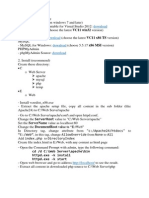Best Practices: Find Answers On The Fly, or Master Something New. Subscribe Today
Uploaded by
Dallas GuyBest Practices: Find Answers On The Fly, or Master Something New. Subscribe Today
Uploaded by
Dallas GuyPREV NEXT
⏮ Common messaging publishing patterns Building Data Streaming Applications with Apache Kafka Summary ⏭
Best practices
Hopefully, at this juncture, you are very well aware of Kafka Producer APIs, their internal working, and common
patterns of publishing messages to different Kafka topics. This section covers some of the best practices
associated with Kafka producers. These best practices will help you in making some of the design decisions for
the producer component.
Let's go through some of the most common best practices to design a good producer application:
Data validation: One of the aspects that is usually forgotten while writing a producer system is to perform
basic data validation tests on data that is to be written on the Kafka cluster. Some such examples could be
conformity to schema, not null values for Key fields, and so on. By not doing data validation, you are risking
breaking downstream consumer applications and affecting the load balancing of brokers as data may not be
partitioned appropriately.
Exception handling: It is the sole responsibility of producer programs to decide on program flows with
respect to exceptions. While writing a producer application, you should define different exception classes and
as per your business requirements, decide on the actions that need to be taken. Clearly defining exceptions not
only helps you in debugging but also in proper risk mitigation. For example, if you are using Kafka for critical
applications such as fraud detection, then you should capture relevant exceptions to send e-mail alerts to the
Find answers on the fly, or master something new. Subscribe today. See pricing options.
OPS team for immediate resolution.
Number of retries: In general, there are two types of errors that you get in your producer application. The
first type are errors that producer can retry, such as network timeouts and leader not available. The second
type are errors that need to be handled by producer programs as mentioned in the preceding section.
Configuring the number of retries will help you in mitigating risks related to message losses due to Kafka
cluster errors or network errors.
Number of bootstrap URLs: You should always have more than one broker listed in your bootstrap broker
configuration of your producer program. This helps producers to adjust to failures because if one of the
brokers is not available, producers try to use all the listed brokers until it finds the one it can connect to. An
ideal scenario is that you should list all your brokers in the Kafka cluster to accommodate maximum broker
connection failures. However, in case of very large clusters, you can choose a lesser number that can
significantly represent your cluster brokers. You should be aware that the number of retries can affect your
end-to-end latency and cause duplicate messages in your Kafka queues.
Avoid poor partitioning mechanism: Partitions are a unit of parallelism in Kafka. You should always choose
an appropriate partitioning strategy to ensure that messages are distributed uniformly across all topic
partitions. Poor partitioning strategy may lead to non-uniform message distribution and you would not be able
to achieve the optimum parallelism out of your Kafka cluster. This is important in cases where you have
chosen to use keys in your messages. In case you do not define keys, then producer will use the default round-
robin mechanism to distribute your messages to partitions. If keys are available, then Kafka will hash the keys
and based on the calculated hash code, it will assign the partitions. In a nutshell, you should choose your keys
in a way that your message set uses all available partitions.
Temporary persistence of messages: For highly reliable systems, you should persist messages that are
passing through your producer applications. Persistence could be on disk or in some kind of database.
Persistence helps you replay messages in case of application failure or in case the Kafka cluster is unavailable
due to some maintenance. This again, should be decided based on enterprise application requirements. You
can have message purging techniques built in your producer applications for messages that are written to the
Kafka cluster. This is generally used in conjunction with the acknowledgement feature that is available with
Kafka Producer APIs. You should purge messages only when Kafka sends a success acknowledgement for a
message set.
Avoid adding new partitions to existing topics: You should avoid adding partitions to existing topics when
you are using key-based partitioning for message distribution. Adding new partitions would change the
calculated hash code for each key as it takes the number of partitions as one of the inputs. You would end up
having different partitions for the same key.
Support / Sign Out
© 2021 O'Reilly Media, Inc. Terms of Service / Privacy Policy
You might also like
- Database Concepts: James River Jewelry Project Questions100% (2)Database Concepts: James River Jewelry Project Questions16 pages
- Optimizing Your Apache Kafka DeploymentNo ratings yetOptimizing Your Apache Kafka Deployment39 pages
- 20200706-WP-Optimizing Your Apache Kafka DeploymentNo ratings yet20200706-WP-Optimizing Your Apache Kafka Deployment32 pages
- Kafka Producer Internals: Find Answers On The Fly, or Master Something New. Subscribe TodayNo ratings yetKafka Producer Internals: Find Answers On The Fly, or Master Something New. Subscribe Today1 page
- Top Answers To Kafka Interview QuestionsNo ratings yetTop Answers To Kafka Interview Questions3 pages
- Instaclustr Understanding Apache Kafka White PaperNo ratings yetInstaclustr Understanding Apache Kafka White Paper8 pages
- Benchmarking Apache Kafka - 2 Million Writes Per Second (On Three Cheap Machines) - LinkedIn EngineeringNo ratings yetBenchmarking Apache Kafka - 2 Million Writes Per Second (On Three Cheap Machines) - LinkedIn Engineering9 pages
- Learning Apache Kafka - Second Edition - Sample ChapterNo ratings yetLearning Apache Kafka - Second Edition - Sample Chapter12 pages
- 20231206-EB-Top Six Kafka Projects FailNo ratings yet20231206-EB-Top Six Kafka Projects Fail11 pages
- 20 Best Practices For Working With Apache Kafka at Scale - DZone Big DataNo ratings yet20 Best Practices For Working With Apache Kafka at Scale - DZone Big Data10 pages
- Recommendations For Deploying Apache Kafka On KubernetesNo ratings yetRecommendations For Deploying Apache Kafka On Kubernetes9 pages
- Advanced Apache Kafka: Engineering High-Performance Streaming ApplicationsFrom EverandAdvanced Apache Kafka: Engineering High-Performance Streaming ApplicationsNo ratings yet
- Kafka vs Message Queue_ A Quick Comparison 2024No ratings yetKafka vs Message Queue_ A Quick Comparison 20249 pages
- Dependency-Based Automatic Parallelization of Java ApplicationsNo ratings yetDependency-Based Automatic Parallelization of Java Applications13 pages
- Apache Kafka Confluent Enterprise Ref ArchitectureNo ratings yetApache Kafka Confluent Enterprise Ref Architecture17 pages
- 20180619-WP-Recommendations For Deploying Apache Kafka On KubernetesNo ratings yet20180619-WP-Recommendations For Deploying Apache Kafka On Kubernetes14 pages
- Mc0071-Software Engineering Test 4.what About The Programming For Reliability?No ratings yetMc0071-Software Engineering Test 4.what About The Programming For Reliability?4 pages
- 01 - Chapter Introduction To AMQ StreamsNo ratings yet01 - Chapter Introduction To AMQ Streams10 pages
- Refactoring to Rust - MEAP Version 5 Lily Mara - The ebook is ready for download, no waiting required100% (1)Refactoring to Rust - MEAP Version 5 Lily Mara - The ebook is ready for download, no waiting required55 pages
- Google Cloud Diagnostic Questions - Analyzing and Optimizing Technical and Business ProcessesNo ratings yetGoogle Cloud Diagnostic Questions - Analyzing and Optimizing Technical and Business Processes5 pages
- Getting To Know Kafka: Ola Is The First Course in The Series of Courses Covering All The Aspects of KafkaNo ratings yetGetting To Know Kafka: Ola Is The First Course in The Series of Courses Covering All The Aspects of Kafka23 pages
- Professional BlazeDS: Creating Rich Internet Applications with Flex and JavaFrom EverandProfessional BlazeDS: Creating Rich Internet Applications with Flex and JavaNo ratings yet
- Kafka's Architecture: Find Answers On The Fly, or Master Something New. Subscribe TodayNo ratings yetKafka's Architecture: Find Answers On The Fly, or Master Something New. Subscribe Today1 page
- Kafka Producer Apis: Find Answers On The Fly, or Master Something New. Subscribe TodayNo ratings yetKafka Producer Apis: Find Answers On The Fly, or Master Something New. Subscribe Today1 page
- Message Partitions: Find Answers On The Fly, or Master Something New. Subscribe TodayNo ratings yetMessage Partitions: Find Answers On The Fly, or Master Something New. Subscribe Today1 page
- Conventions - Building Data Streaming Applications With Apache KafkaNo ratings yetConventions - Building Data Streaming Applications With Apache Kafka1 page
- Custom Partition - Building Data Streaming Applications With Apache KafkaNo ratings yetCustom Partition - Building Data Streaming Applications With Apache Kafka1 page
- Advance Queuing Messaging Protocol - Building Data Streaming Applications With Apache KafkaNo ratings yetAdvance Queuing Messaging Protocol - Building Data Streaming Applications With Apache Kafka1 page
- Additional Producer Configuration: Find Answers On The Fly, or Master Something New. Subscribe TodayNo ratings yetAdditional Producer Configuration: Find Answers On The Fly, or Master Something New. Subscribe Today1 page
- Visual Cryptography: Cryptography" Aims at Providing The Voters A Facility To Cast Their Vote For The ElectionsNo ratings yetVisual Cryptography: Cryptography" Aims at Providing The Voters A Facility To Cast Their Vote For The Elections21 pages
- Information Needed in Tuning A SQL QueryNo ratings yetInformation Needed in Tuning A SQL Query12 pages
- Low Level Design LLD Document Template.docx (1)No ratings yetLow Level Design LLD Document Template.docx (1)6 pages
- $ Wget - H GNU Wget 1.10.2, A Non-Interactive Network Retriever.100% (2)$ Wget - H GNU Wget 1.10.2, A Non-Interactive Network Retriever.3 pages
- EBSPROD - Switchover - Switchback - Version 1.0No ratings yetEBSPROD - Switchover - Switchback - Version 1.020 pages
- Select All Lines Using Personalization: On Manage Buyer Workload Form Utilities:Diagnostics YesNo ratings yetSelect All Lines Using Personalization: On Manage Buyer Workload Form Utilities:Diagnostics Yes10 pages
- Project Report On Password Manager With Multi Factor AuthenticationNo ratings yetProject Report On Password Manager With Multi Factor Authentication60 pages
- B.SC., (I.T) Degree Examination November/December 2011 Entrance TestNo ratings yetB.SC., (I.T) Degree Examination November/December 2011 Entrance Test51 pages
- Kotha Uday Kiran: Profile and Core CompetenciesNo ratings yetKotha Uday Kiran: Profile and Core Competencies7 pages
- Development of С/С++ applications for Android* OS: Alexey MoskalevNo ratings yetDevelopment of С/С++ applications for Android* OS: Alexey Moskalev40 pages
- OE CSE VI Information Storage Management OutNo ratings yetOE CSE VI Information Storage Management Out2 pages
- Object Oriented Techniques Using Java (ACSE0302) : Unit: 4No ratings yetObject Oriented Techniques Using Java (ACSE0302) : Unit: 475 pages
- Oracle Webcenter Forms Recognition 11G Release 1 (11.1.1.9.0) Certification MatrixNo ratings yetOracle Webcenter Forms Recognition 11G Release 1 (11.1.1.9.0) Certification Matrix5 pages
- Data Structures Module 3 QB Complete SolutionsNo ratings yetData Structures Module 3 QB Complete Solutions73 pages
- Development of A University Financial Data Warehouse and Its Visualization ToolNo ratings yetDevelopment of A University Financial Data Warehouse and Its Visualization Tool9 pages
































































































